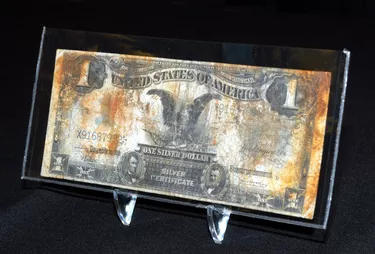
Silver certificate dollar bills were issued by the U.S. government between 1878 and 1964. While once redeemable for silver dollar coins or silver bullion, the bills are now only worth face value. Depending on their rarity and condition, however, they may be valuable to collectors.
The Origin of Silver Certificates
Video of the Day
People generally find it more convenient to carry and use paper bills than metal coins. The Bland-Allison Act of 1878 allowed Americans to deposit silver coins in the Treasury in exchange for bills, as long as the amount was less than $10. As explained on the U.S. Department of Treasury website, Congress authorized the issuance of silver certificates. Series 1878 silver certificates were issued in denominations of $10, $20, $50, $100, $500 and $1,000. The $1, $2 and $5 denominations were introduced as Series 1886. In 1896, issuance ended for all denominations except $10 and under.
Video of the Day
Silver certificates were very popular and used commonly until the mid-20th century. The amount of silver and silver dollars in the Treasury declined and with it the government's ability to back silver certificates. In 1963, Congress decided that silver certificates of any denomination would no longer be issued; 1965 was the last year of production
Total Silver Certificate Production
The total value of silver certificates produced by denomination between 1878 and 1965 shows that the bills were not particularly rare. Using data from the Department of the Treasury website, the total number of bills produced in each denomination is as follows:
- $1: 38,549,291,941
- $2: 601,359,000
- $5: 3,423,174,170
- $10: 230,688,170
Silver Certificates as Collectibles
CoinWeek, an Internet-based publication for numismatists (coin collectors), states that silver certificates are perhaps the most popular and widely collected of all U.S. paper currencies. Some are collectible because of their beautiful artistry, particularly bills printed before 1928. Other bills are highly collectible because of their rarity, which has to do with the number of bills printed and the condition of an individual bill. Uncirculated bills have the highest value. The value can be reduced by more than half for a bill in what's considered "very fine" condition. Well-used bills may have no more than face value.
Consider also: How to Calculate the Value of Your Old Silver Coins
Value of a 1928 Silver Certificate
Series 1928 silver certificates were limited to $1 bills. The year 1928 was significant because it was the first year that smaller-sized bills were introduced. The Department of Treasury sought to cut production costs by reducing the size of bills by 50 percent. As explained by the experts at Littleton Coin Company, the large bills were masterpieces of design and showcased some of the finest examples ever seen of the art of engraving.
According to coin dealers at Silver Recyclers, there were about 640 million one dollar 1928 silver certificates printed. The bills were nicknamed "funny backs," since a new design was featured for the first time on the reverse of the bill. George Washington's portrait is seen on the front; on the back, the word "one" appears in a font that had not been used previously on U.S. currency. Because so many bills were printed, the 1928 one dollar bill silver certificate is not particularly rare. There are a few exceptions, however. Silver Recyclers values a 1928E series note at $1,350 in uncirculated condition. The value drops to $500 for a note in very fine condition.
Other series and their values, according to Silver Recyclers are as follows:
- 1928: $100 (uncirculated) and $32 (very fine)
- 1928A: $80 (uncirculated) and $30 (very fine)
- 1928B: $85 (uncirculated) and $30 (very fine)
- 1928C: $600 (uncirculated) and $300 (very fine)
- 1928D: $325 (uncirculated) and $325 (very fine)
- US Department of the Treasury Bureau of Engraving and Printing
- Sapling: How to Calculate the Value of Your Old Silver Coins
- CoinWeek: Silver Certificates: Why Were They Issued and How Much are They Worth?
- Littleton Coin Company: Large-Size U.S. Paper Money
- Silver Recyclers: 1928 One Dollar Silver Certificate